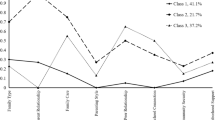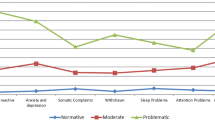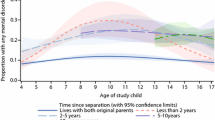Abstract
Background
Data based on general population studies of exposure-to-risk factors is not adequate to describe the mental health of children living in the most extreme “high-risk” environments.
Methods
Data were collected in a longitudinal prospective study of two cohorts of 9 and 13 year-old socially at-risk children. Cluster analysis was used to classify youths based on the reports about potential areas of risk. The psychopathological structure of empirical clusters was compared through cross-sectional and longitudinal epidemiological indexes and through multiple regression and multivariate analysis of variance.
Results
Cluster analysis provided eight binary high-low risk classifications. Exposure to risk was highly prevalent. In preadolescence, broken family, parenting style and contextual profiles were the highest risk factors for psychopathology. In adolescence, they were psychological variables, verbal comprehension, pre-peri-postnatal history, physical health and family characteristics. Cumulative risk followed a linear trend for psychopathology and functional impairment. The child’s perception of low marital discord and good school achievement were protective factors.
Conclusions
Extreme socially at-risk populations have specific profiles of risk that can be identified through a person-centered approach and may be amenable to selective preventive interventions.

Similar content being viewed by others
Abbreviations
- AFp:
-
Population attributable fraction
References
Allen NB, Lewinsohn PM, Seeley JR (1998) Prenatal and perinatal influences on risk for psychopathology in childhood and adolescence. Dev Psychopathol 10:513–529
American Psychiatric Association (1994) Diagnostic and statistical manual of mental disorders-IV. Author, Washington
Appleyard K, Egeland B, van Dulmen MHM, Sroufe A (2005) When more is not better: the role of cumulative risk in child behavior outcomes. J Child Psychol Psychiatry 46:235–245
Brozec J, Tiede K (1952) Reliable and questionable significance in a series of statistical tests. Psychol Bull 49:339–341
Burchinal M, Roberts JE, Zeisel SA, Hennon EA, Hooper SR (2006) Social risk and protective child, parenting, and child care factors in early elementary school years. Parenting-Sci Pract 6:79–113
Canty-Mitchell J, Austin JK, Jaffee K, Qi RA, Swigonski N (2004) Behavioral and mental health problems in low-income children with special health care needs. Arch Psychiatr Nurs 18:79–87
Costello EJ, Compton SN, Keeler G, Angold A (2003) Relationship between poverty and psychopathology. JAMA 290:2023–2029
Costello EJ, Egger HL, Angold A (2005) 10-year research update review: the epidemiology of child and adolescent psychiatric disorders: I. Methods and public health burden. J Am Acad Child Adolesc Psychiatry 44:972–986
Costello EJ, Foley D, Angold A (2006) 10-year research update review: the epidemiology of child and adolescent psychiatric disorders: II. Developmental epidemiology. J Am Acad Child Adolesc Psychiatry 45:8–25
Crockett LJ, Moilanen KL, Raffaelli M, Randall BA (2006) Psychological profiles and adolescent adjustment: a person-centered approach. Dev Psychopathol 18:195–214
Cummings EM, Davies PT (2002) Effects of marital conflict on children: Recent advances and emerging themes in process-oriented research. J Child Psychol Psychiatry 43:31–64
Davis CH, MacKinnon DP, Schultz A, Sandler I (2003) Cumulative risk and population attributable fraction in prevention. J Clin Child Adolesc Psychol 32:228–235
Dishion TJ (2000) Cross-setting consistency in early adolescent psychopathology: deviant friendships and problem behavior sequelae. J Pers 68:1109–1126
Dishion TJ, Poulin F, Medici Skaggs B (1999) The ecology of premature adolescent autonomy: biological and social influences. In: Kerns KA, Contreras JM, Neal-Baret M (eds) Explaining associations between family and peer relationships. Praeger, Westport
DiStefano C, Kamphaus RW, Horne AM, Winsor A (2003) Behavioral adjustment in the. U.S. Elementary school: cross-validation of a person-oriented typology of risk. J Psychoeduc Assess 21:338–357
Dunn LM (1984) Vocabulario en imágenes Peabody. Adaptación española. Mepsa, Madrid
Essex MJ, Kraemer HC, Armstrong JM, Boyce T, Goldsmith HH, Klein MH, Woodward H, Kupfer DJ (2006) Exploring risk factors for the emergence of children’s mental health problems. Arch Gen Psychiatry 63:1246–1256
Ezpeleta L, de la Osa N, Júdez J, Doménech JM, Navarro JB, Losilla JM (1997) Diagnostic agreement between clinician and the diagnostic interview for children and adolescents—DICA-R in a Spanish outpatient sample. J Child Psychol Psychiatry 38:431–440
Ezpeleta L, Granero R, de la Osa N (1999) Evaluación del deterioro en niños y adolescentes a través de la children’s global assessment scale (CGAS). Rev Psiquiatr Infanto-Juv 1:18–26
Ezpeleta L, Granero R, de la Osa N, Guillamon N (2000) Predictors of functional impairment in children and adolescents. J Child Psychol Psychiatry 41:793–801
Ezpeleta L, Guillamón N, Granero R, de la Osa N, Doménech JM, Moya I (2007) Prevalence of mental disorders in children and adolescents from a Spanish slum. Soc Sci Med 64:842–849
Ford T, Collishaw S, Meltzer H, Goodman R (2007) A prospective study of childhood psychopathology: independent predictors of change over three years. Soc Psychiatry Psychiatr Epidemiol 42:953–961
Good MD, Smilkstein G, Good BJ, Shaffer T, Arons T (1979) The family APGAR indices: a study of construct validity. J Fam Pract 8:577–582
Goodman S, Hoven C, Narrow W, Cohen P, Fielding B, Alegria M, Leaf PJ, Kandel D, Horwitz SM, Bravo M, Moore R, Dulcan MK (1998) Measurement of risk for mental disorders and competence in a psychiatric epidemiologic community survey: the national institute of mental health methods for the epidemiology of child and adolescent mental disorders (MECA). Soc Psychiatry Psychiatr Epidemiol 33: 162–173
Granero R, Ezpeleta L, Doménech JM (2007) Features associated with non-participation and abandonment in mental health epidemiological designs of socially-at-risk children and adolescents. Soc Psychiatry Psychiatr Epidemiol 42:251–258
Greenberg MT, Speltz ML, DeKlyen M, Jones K (2001) Correlates of clinic referral for early conduct problems: variable- and person-oriented approaches. Dev Psychopathol 13:255–276
Grynch J, Seid M, Finchman F (1992) Assessing marital conflict from the child’s perspective: the child’s perception of interparental conflict scale. Child Dev 63:558–572
Guillamon N (1999) Fiabilidad entre entrevistadores del Protocolo de Factores de Riesgo-Versión niños. Unpublished manuscript Universitat Autònoma de Barcelona
Hollingshead AB (1975) Four factor index of social status. Unpublished manuscript, Yale University, Department of Sociology, New Haven, CT
Hooper SR, Roberts JE, Zeisel SA, Poe M (2003) Core language predictors of behavioral functioning in early elementary school children: concurrent and longitudinal findings. Behav Disord 29:10–24
Johnson JH, McCutcheon SM (1980) Assessing life stress in older children and adolescents: preliminary findings with the life events checklist. In: Saranson I, Spielberger CD (eds) Stress and anxiety. Hemisphere, Washington, pp 111–125
Jones DJ, Forehand R, Brody G, Armistead L (2002) Psychosocial adjustment of African American children in single-mother families: a test of three risk models. J Marriage Fam 64:105–115
Lish JD, Weissman MM, Adams PB, Hoven CW, Bird HR (1995) Family psychiatric screening instrument for epidemiological studies: pilot testing and validation. Psychiatry Res 57:169–180
Luby JL, Belden AC, Spitznagel E (2006) Risk factors for preschool depression: the mediating role of early stressful life events. J Child Psychol Psychiatry 47:1292–1298
Masten AS, Obradovic J (2006) Competence and resilience in development. Ann N Y Acad Sci 1094:13–27
Muris P, Ollendick TH (2005) The role of temperament in the etiology of child psychopathology. Clin Child Fam Psychol Rev 8:271–289
Nation M, Crusto C, Wandersman A, Kumpfer KL, Seybolt D, Morrisey-Kane E, Davino K (2003) What works in prevention: principles of effective prevention programs. Am Psychol 58:449–456
Prelow HM, Weaver SR, Swenson RR (2005) Competence, self-esteem, and coping efficacy as mediators of ecological risk and depressive symptoms in urban African American and European American youth. J Adolesc 35:507–517
Reich W (2000) Diagnostic interview for children and adolescents (DICA). J Am Acad Child Adolesc Psychiatry 39:59–66
Rutter M, Cox A, Tupling C, Berger M, Yule W (1975) Attainment and adjustment in 2 geographical areas.1. Prevalence of psychiatric-disorders. Br J Psychiatry 126:493–509
Sakoda JM, Cohen BH, Beall G (1954) Test of significance for a series of statistical tests. Psychol Bull 51:172–175
Sameroff AJ, Bartko WT, Baldwin A, Baldwin C, Seifer R (1998) Family and social influences on the development of child competence. In: Lewis M, Feiring C (eds) Families, risk, and competence. Lawrence Erlbaum Associates, Mahwah, pp 161–186
Sandler I (2001) Quality and ecology of adversity as common mechanisms of risk and resilience. Am J Community Psychol 29:19–61
Shaffer D, Gould MS, Brasic J, Ambrosini P, Fisher P, Bird H, Aluwahlia S (1983) A children’s global assessment scale (CGAS). Arch Gen Psychiatry 40:1228–1231
Spanier GB (1976) Measuring dyadic adjustment: A new scale for assessing the quality of marriage and similar dyads. J Marriage Fam 38:15–28
Tu S (2003) Developmental epidemiology: a review of three key measures of effect. J Clin Child Adolesc Psychol 32:187–192
Unitat d’Epidemiologia i de Diagnòstic en Psicopatologia del Desenvolupament (1997) Protocolo de Factores de Riesgo. Versión para padres. Universitat Autònoma de Barcelona, Departament de Psicologia Clínica i de la Salut, Barcelona
Wakschlag LS, Leventhal BL, Pine DS, Pickett KE, Carter AS (2006) Elucidating early mechanisms of developmental psychopathology: the case of prenatal smoking and disruptive behavior. Child Dev 77:893–906
Wamboldt MZ, Wamboldt FS (2000) Role of the family in the onset and outcome of childhood disorders: selected research findings. J Am Acad Child Adolesc Psychiatry 39: 1212–1219
Weissberg RP, Kumpfer KL, Seligman MEP (2003) Prevention that works for children and youth—an introduction. Am Psychol 58:425–432
Williamson DE, Birmaher B, Dahl RE, Ryan ND (2005) Stressful life events in anxious and depressed children. J Child Adolesc Psychopharmacol 15:571–580
Acknowledgments
This study was supported by grants BS02002-3850 and SEJ2005-01786 of the Ministry of Science and Technology, Spain. We wish to thank the City Council and Educational and Health Centers of Badía del Vallés for their support.
Author information
Authors and Affiliations
Corresponding author
Rights and permissions
About this article
Cite this article
Ezpeleta, L., Granero, R., de la Osa, N. et al. Risk factor clustering for psychopathology in socially at-risk Spanish children. Soc Psychiat Epidemiol 43, 559–568 (2008). https://doi.org/10.1007/s00127-008-0312-6
Received:
Accepted:
Published:
Issue Date:
DOI: https://doi.org/10.1007/s00127-008-0312-6




